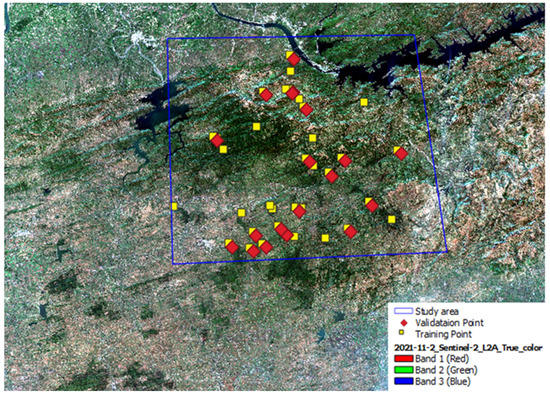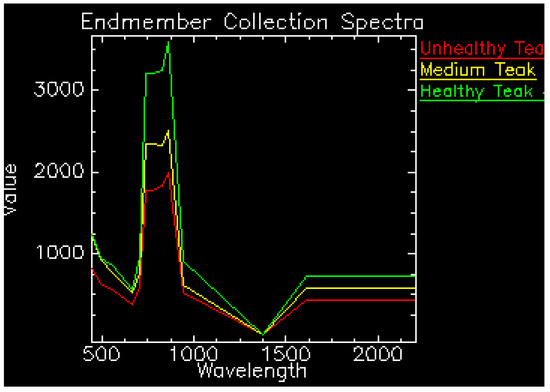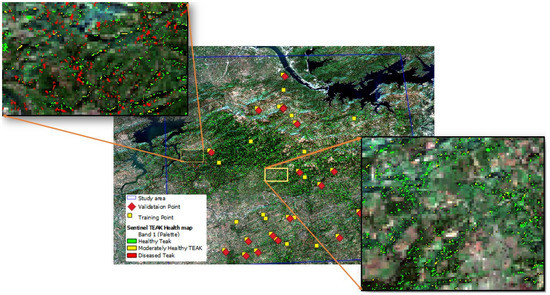Abstract
The functional activity of a tree is affected by various biotic and abiotic factors. The vitality and health status of a tree also affects the growth. Recent remote sensing technologies provide pow-erful means for monitoring forest health. The aim of this study is to discriminate Tectona grandis L. healthy trees from non-healthy or infected trees using the Spectral Angle Mapper (SAM) algorithm. The present study site was located in a Southern Tropical Dry Deciduous Forests, of Gujarat, western India. The forest was dominated by Tectona grandis L. The healthy and the unhealthy plots of T. grandis were chosen for the present research. Vitality of T. grandis was understood after detailed study on damage assessment in 45 different plots distributed in the study area. A mask for forest area from non-forest area was applied to extract forest area from the data. Pure endmembers of the masked dataset for healthy and non-healthy or infected tree were extracted. By utilizing the derived pure endmembers, spectral angle mapping was applied to differentiate between healthy and non-healthy or infected trees in the image. The results show that SAM of Sentinel-2 data can provide T. grandis maps that compare favorably with ground truth, suggesting that there is a great potential of discrimination of T. grandis healthy trees from the non-healthy or infected using Sentinel-2 data.
1. Introduction
The environmental health of our planet depends heavily on forestland. Globally, forests are under strain from both human and natural sources. The air we breathe and the goods we consume come from forests. The world’s forests, which are the planet’s largest terrestrial ecosystems, are important for promoting social, economic, and ecological well-being [1,2]. Threats to forests, including severe drought and insect scourges, are present. Pests could permanently harm vegetative cover. The state of the forest stand, however, to have a considerable impact on the overall service provided by them [3]. The key to monitor forest health is through use of satellite data, specifically, multispectral imagery. Multispectral imagery has been the most widely used data in species composition mapping studies [4], in forest biomass and carbon [5,6,7,8], forest diversity [9,10], and various parameter retrieval. Satellite image with high spectral capabilities, such as hyperspectral sensors, monitors earth surface as well. It contains a continuous narrow band surface allows to capture the biochemical composition of vegetation [11,12]. They provide a fair level of detail. Therefore, in many studies, hyperspectral data are better than multispectral images.
With now free availability of high resolution and multi-spectral data, such as Sentinel-2 data, which can be proven to be beneficial for forest mapping, high resolution images have also demonstrated themselves to be useful in isolating individual trees.
Therefore, in the present study, the potential of Sentinel-2 data will be utilized for mapping Teak health conditions. The objective of the present study was to discrimination of Tectona grandis L. healthy and non-healthy tree species using Spectral Angle Mapper.
2. Study Area
The Shoolpaneshwar Wildlife Sanctuary forests in south Gujarat are remnants of some of the finest forests in the Narmada District, Gujarat. It is spread out between 21°38′0″ North, 73°35′0″ East (Figure 1). They are home to a variety of natural resources and a diversity of flora and fauna. The two Forest types found in the area are not distinctly reflected on topography. The moist Tectona grandis L. (Teak) forests are found in Fulsar, Piplod, and Sagai ranges of the sanctuary. The composition of teak is usually 25% of the total crop. The dry teak forests also occur in the same locality within a short distance, but are mostly found on poor soils, hill ridges, and areas subjected to biotic interference.

Figure 1.
True color composite (665, 560, 443 nm, RGB) of Shoolpaneshwar Wildlife Sanctuary derived from Sentinel-2A data. Blue box shows study area.
3. Methodology
For Present Study Pure Tectona grandis L. plot were selected. We established 45 plots located Shoolpaneshwar Wildlife Sanctuary Dediapada of Narmada District. At each stand plot was marked with 30 m × 30 m (900 m2) and bounded by a buffer zone of 10 m wide having composition and structure, to avoid edge effects. Each plot was divided into 9 subplots with 10 × 10 m size. At each quadrat, the total number of trees was thoroughly counted. All woody species that were within the plots at Breast Height (DBH) (1.3 m) were identified by counting at a species level. The coordinates of the plot boundary and the location of each tree were recorded using a handheld global positioning system with sub-meter accuracy. Tree health was identified through visual inspection, taking account of various parameters, such as an unbalanced crown, weak or yellowing foliage, defoliation, dead or broken branches, poor branch attachment, lean, pruning scars, basal/trunk scars, conks, rot/cavity, cracks, girdling roots, exposed surface roots. Based upon the parameters rating was provided on scale of 1–5, 1 indicating poor health status and 5 indicating healthy tree species.
Model Development
In the present study, freely available Sentinel-2 images (Level-2A product reflectance) were downloaded from the Copernicus Open Access Hub (https://scihub.copernicus.eu/ accessed on 1 June 2022), for the date 28 November 2021. This month was chosen because trees show maximum leaf and growth during this time. The data was resampled at a 10 m resolution. Based upon the above rating, healthy and non-healthy tree species’ differentiating qualities were derived from the Sentinel-2 data. Which was further used for discriminating against the non-healthy tree species using Spectral Angle Mapper (SAM). Out of 45 plots, 20 plots were kept aside for data validation.
4. Result and Discussion
Discriminatory differences between healthy and non-healthy Teak plants were retrieved using three steps. First, identification of healthy and non-healthy in 45 plots using visual inspection of tree species. Secondly, spectra was collected from Sentinel-2 data after resampling at 10 m resolution. Lastly, the spectra (Figure 2) was utilized for Spectral Angle Mapper (SAM) based classification. Image was then subjected to data validation.

Figure 2.
An average of spectra for Tectona grandis L. in 45 plots.
Spectral Angle Mapper is a physical based classification system known as Spectral Angle Mapper (SAM) that utilizes an n-D angle to match pixels to reference spectra. The algorithm calculates the angle between two spectra. The distance between bands is measured to determine the similarity between two spectra. This method, when practiced in calibrated reflectance data, is relatively insensitive to light and light reflection. Endmember spectra can be directly extracted by the ROI mean spectra from the image. SAM then computes the angle or the angle distribution of each pixel vector in n-D space and indicates which pixels represent good matches to each endmember. Pixels further than a specified maximum angle threshold are not classified. SAM classification assumes reflectance data. The results showed that SAM was able to discriminate Healthy Teak from Non-healthy Teak species (Figure 3).

Figure 3.
Mapping of Tectona grandis L. using Sentinel-2 data.
Accuracy
For accuracy, 20 validation plots were plotted in Tectona grandis L. health map. Out of 20 plots surveyed from ground, the accuracy of the data was founded to be 75%.
5. Conclusions
The results show that SAM of Sentinel-2 data can provide T. grandis maps that compare favorably with ground truth. Suggesting that there is a great potential of discrimination of T. grandis healthy trees from the non-healthy or infected using Sentinel-2 data. The overall good performance with 75% accuracy shows better potential of Sentinel-2 data regarding forest monitoring and it will effectively improve the monitoring of Forest health mapping and can utilized by forest managers for planning purpose.
Funding
This research received no external funding.
Institutional Review Board Statement
Not applicable.
Informed Consent Statement
Not applicable.
Data Availability Statement
The study has been used Sentinel-2 multispectral imagery that is available at https://scihub.copernicus.eu (accessed on 1 October 2022).
Conflicts of Interest
The author declares no conflict of interest.
References
- Davis, L.S.; Norman Johnson, K.; Bettinger, P.S.; Howard, T.E.; Alván Encinas, L.; Salazar, M.; Gretzinger, S.; Lange, G.; Schmithusen, F.; Hyde, W.; et al. Forest Management: To Sustain Ecological, Economic, and Social Values; Universidad Nacional Agraria La Molina: Lima, Perú, 2001. [Google Scholar]
- Buschbacher, R.J. Natural forest management in the humid tropics: Ecological, social, and economic considerations. Ambio 1990, 19, 253–258. [Google Scholar]
- Meng, J.; Li, S.; Wang, W.; Liu, Q.; Xie, S.; Ma, W. Mapping Forest Health Using Spectral and Textural Information Extracted from SPOT-5 Satellite Images. Remote Sens. 2016, 8, 719. [Google Scholar] [CrossRef]
- Kiran, S.G.; Mudaliar, A. Remote sensing & Geo-informatics technology in evaluation of forest tree diversity. Asian J. Plant Sci. Res. 2012, 2, 237–242. [Google Scholar]
- Andersen, H.-E.; Strunk, J.; Temesgen, H.; Atwood, D.; Winterberger, K. Using multilevel remote sensing and ground data to estimate forest biomass resources in remote regions: A case study in the boreal forests of Interior Alaska. Can. J. Remote Sens. 2012, 37, 596–611. [Google Scholar] [CrossRef]
- Du, L.; Zhou, T.; Zou, Z.; Zhao, X.; Huang, K.; Wu, H. Mapping forest biomass using remote sensing and national forest inventory in China. Forests 2014, 5, 1267–1283. [Google Scholar] [CrossRef]
- Egli, S. Mycorrhizal mushroom diversity and productivity—An indicator of forest health? Ann. For. Sci. 2011, 68, 81–88. [Google Scholar] [CrossRef]
- Zhang, J.; Huang, S.; Hogg, E.; Lieffers, V.; Qin, Y.; He, F. Estimating spatial variation in alberta forest biomass from a combination of forest inventory and remote sensing data. Biogeosciences 2014, 11, 2793–2808. [Google Scholar] [CrossRef]
- Getzin, S.; Wiegand, K.; Schöning, I. Assessing biodiversity in forests using very high-resolution images and unmanned aerial vehicles. Method. Ecol. Evol. 2012, 3, 397–404. [Google Scholar] [CrossRef]
- Peduzzi, A.; Wynne, R.H.; Fox, T.R.; Nelson, R.F.; Thomas, V.A. Estimating leaf area index in intensively managed pine plantations using airborne laser scanner data. For. Ecol. Manag. 2012, 270, 54–65. [Google Scholar] [CrossRef]
- Fassnacht, F.E.; Latifi, H.; Stereńczak, K.; Modzelewska, A.; Lefsky, M.; Waser, L.T.; Straub, C.; Ghosh, A. Review of studies on tree species classification from remotely sensed data. Remote Sens. Environ. 2016, 186, 64–87. [Google Scholar] [CrossRef]
- Madonsela, S.; Cho, M.A.; Mathieu, R.; Mutanga, O.; Ramoelo, A.; Kaszta, Z.; Van De Kerchove, R.; Wolff, E. Multi-phenology WorldView-2 imagery improves remote sensing of savannah tree species. Int. J. Appl. Earth Obs. Geoinf. 2017, 58, 65–73. [Google Scholar] [CrossRef]
Publisher’s Note: MDPI stays neutral with regard to jurisdictional claims in published maps and institutional affiliations. |
© 2022 by the author. Licensee MDPI, Basel, Switzerland. This article is an open access article distributed under the terms and conditions of the Creative Commons Attribution (CC BY) license (https://creativecommons.org/licenses/by/4.0/).